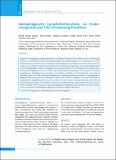Please use this identifier to cite or link to this item:
https://hdl.handle.net/20.500.14356/987Full metadata record
| DC Field | Value | Language |
|---|---|---|
| dc.contributor.author | Poudyal, Bishesh Sharma | - |
| dc.contributor.author | Poudel, Bishal | - |
| dc.contributor.author | Tuladhar, Sampurna | - |
| dc.contributor.author | Rijal, Swarup Sharma | - |
| dc.contributor.author | Shrestha, Gentle Sunder | - |
| dc.contributor.author | Joshi, Utsav | - |
| dc.date.accessioned | 2023-04-19T05:48:36Z | - |
| dc.date.available | 2023-04-19T05:48:36Z | - |
| dc.date.issued | 2022 | - |
| dc.identifier.citation | PoudyalB. S., PoudelB., TuladharS., RijalS. S., ShresthaG. S., & JoshiU. (2023). Hemophagocytic Lymphohistiocytosis: an Under-recognized and Life-threatening Condition . Journal of Nepal Health Research Council, 20(3), 794-796. https://doi.org/10.33314/jnhrc.v20i3.4315 | en_US |
| dc.identifier.issn | Print ISSN: 1727-5482; Online ISSN: 1999-6217 | - |
| dc.identifier.uri | http://103.69.126.140:8080/handle/20.500.14356/987 | - |
| dc.description | Short Communication | en_US |
| dc.description.abstract | Abstract Diagnosis of hemophagocytic lymphohistiocytosis is a challenge in Nepal because of limited resources and the high prevalence of tropical febrile illness mimicking hemophagocytic lymphohistiocytosis. We retrospectively reviewed medical records of 21 patients who were diagnosed with hemophagocytic lymphohistiocytosis from 2010 to 2015 at a single center in Nepal. Two patients had a mutation in their perforin gene and underwent successful haploidentical stem cell transplantation. Marrow hemophagocytosis was found only in 57% of the patients. Five patients had hematological malignancy and were treated with disease-specific chemotherapy. Seven patients developed hemophagocytic lymphohistiocytosis secondary to an infection, including visceral leishmaniasis, scrub typhus, and Epstein Barr virus. EBV-associated hemophagocytic lymphohistiocytosis was refractory to hemophagocytic lymphohistiocytosis 94 protocol, including the addition of rituximab. Malignancy and infection-associated hemophagocytic lymphohistiocytosis was more common. The most common clinical presentations included fever, splenomegaly, hyponatremia, liver function derangement, hyperfibrinogenemia, hyperferritinemia, and cytopenia. With a mortality of 29% in our study cohort, hemophagocytic lymphohistiocytosis should be considered a lethal disease, and clinicians should maintain a high index of suspicion to diagnose this disease. Keywords: Hemophagocytic lymphohistiocytosis; infection; malignancy. | en_US |
| dc.language.iso | en | en_US |
| dc.publisher | Nepal Health Research Council | en_US |
| dc.relation.ispartofseries | July-Sep, 2022;4315 | - |
| dc.subject | Hemophagocytic lymphohistiocytosis | en_US |
| dc.subject | infection | en_US |
| dc.subject | malignancy | en_US |
| dc.title | Hemophagocytic Lymphohistiocytosis: an Under-recognized and Life-threatening Condition | en_US |
| dc.type | Journal Article | en_US |
| Appears in Collections: | Vol 20 No 3 Issue 56 july-Sep, 2022 | |
Files in This Item:
| File | Description | Size | Format | |
|---|---|---|---|---|
| 4315-Manuscript-30795-2-10-20230317.pdf | Fulltext Download | 154.1 kB | Adobe PDF |  View/Open |
Items in DSpace are protected by copyright, with all rights reserved, unless otherwise indicated.
